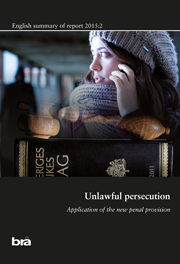- Start
- / Home
- / Publications

Unlawful persecution
The application of the unlawful persecution offence
On 1 October 2011 a new penal provision on unlawful persecution was introduced in the Swedish Penal Code. The aim of the new provision was to incorporate the cases of repeated offences by one person against another, which did not fulfil the criteria for gross violation of integrity and gross violation of a woman’s integrity.
Unabridged original, in Swedish: Olaga förföljelse (2015:2)
The assessment in brief:
It is important that the police develop procedures to ensure that those who register offence reports relating to the crime types included in the unlawful persecution offence always ask the person making the report about possible previous reports and incidents, and that these are then well-documented.
It is equally important that in the next stage the police are aware of the possibility that a report may relate to unlawful persecution. The senior investigating officer who reviews whether the reported act meets the criteria for the registered offence, and who decides whether a criminal investigation should be initiated, must be able to see when several reports have been made relating to offences that may together constitute unlawful persecution.
The suspected cases of unlawful persecution that are identified by police officers (and prosecutors) in the course of an investigation should always be registered in the form of an offence report, so that the statistics relating to the number of unlawful persecution offences brought to the attention of the justice system are correct.
More cases that do not constitute “obvious” instances of unlawful persecution – in terms of the extent, intensity and types of criminal act involved – should be prosecuted in order to develop case law on where the boundaries for the offence should be drawn.
Both police officers and prosecutors would like to see more guidance and more detailed guidelines on where the boundaries for the unlawful prosecution offence should be drawn and on how borderline cases should be assessed.
© The Swedish National Council for Crime Prevention, 2015
Author: Kristina Jerre
urn:nbn:se:bra-582

